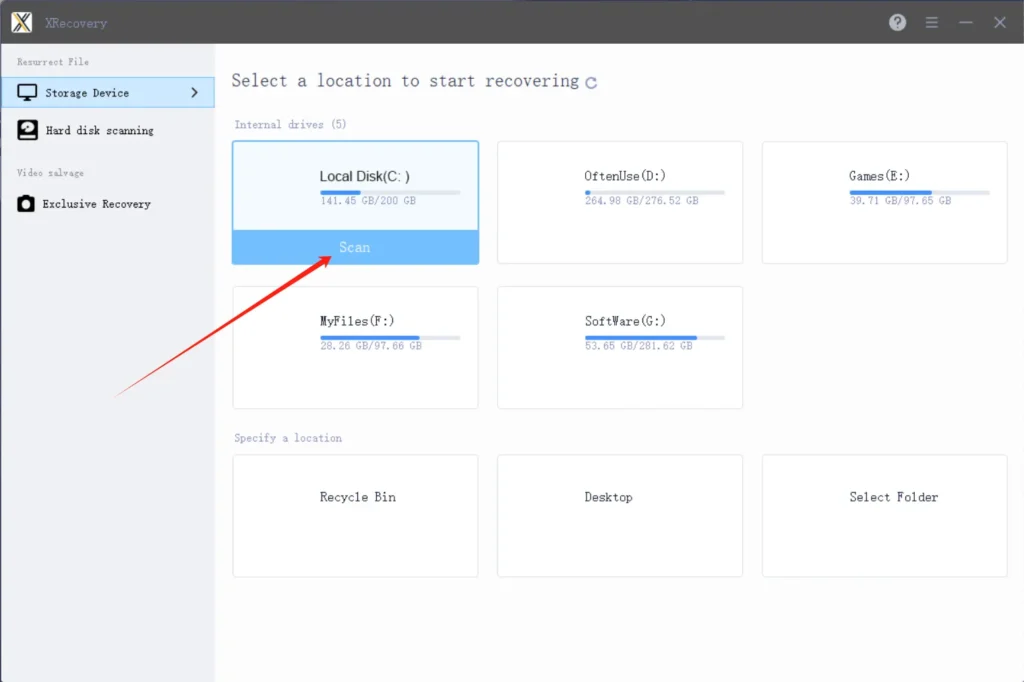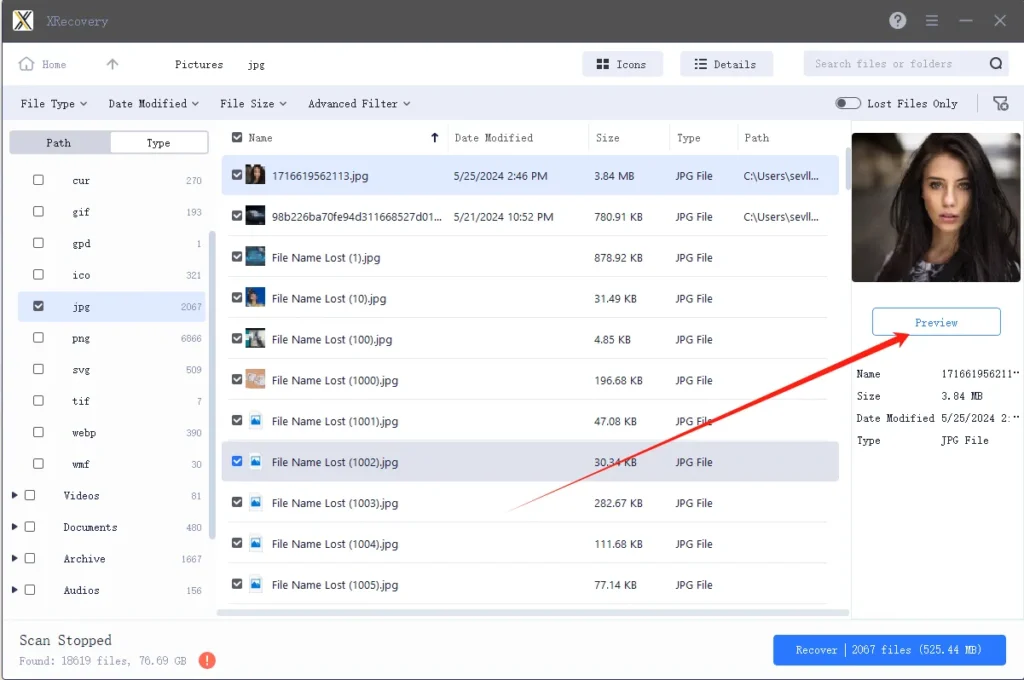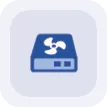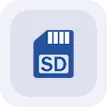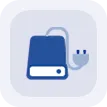Hard Drive Data Recovery Software
XRecovery is a powerful hard drive data recovery solution designed to restore lost or deleted files caused by accidental deletion, formatting errors, file system failures, drive corruption, and other common hard drive issues. Whether you’re recovering work documents lost in a system crash or restoring entire partitions that have become unreadable
Hard Drive Data Recovery Solutions for Every Data Loss Situation
Data loss can happen for many reasons—from accidental deletion to system crashes—making a flexible recovery solution essential. XRecovery offers powerful capabilities to retrieve lost or deleted files across nearly every data loss scenario
emptied the Recycle Bin
Everyone accidentally deletes a file at some point. Even if it’s been removed from your hard drive and the Recycle Bin has been emptied, XRecovery can still retrieve it—quickly and reliably.
Formatted Hard Drives
It’s surprisingly easy to format the wrong hard drive or partition by mistake. Fortunately, XRecovery is equipped to recover data from formatted drives or partitions—helping you avoid major data loss with minimal hassle.
Software Crashes and Viruses
Viruses and malware can cause data loss and make files inaccessible through apps like File Explorer. XRecovery helps restore those hidden or locked files, even on infected systems.
Hard Disk Not Showing Files
If your hard disk isn’t showing files—due to malware, system errors, or corruption—XRecovery provides a reliable fix. It scans affected drives and restores access to files missing from File Explorer, helping you recover critical data with ease.
File System Problems
When a disk suddenly appears as a RAW file system, our hard drive recovery tool can thoroughly scan the device and safely restore your valuable data—even when standard access methods fail.
Hardware Damage
Hardware damage to a hard drive can result from shock, overheating, power surges, or worn components. Symptoms include clicking sounds, failure to spin up, or the drive not being recognized—issues that often require specialized recovery tools to safely retrieve dat
How to Recover Files From a Hard Drive
Here are the simple steps to recover lost or deleted files from a hard drive using XRecovery for Windows.
What Sets XRecovery Apart
XRecovery is a powerful data recovery solution designed to handle a wide range of data loss scenarios, including hard drive failures, accidental file deletions, and system crashes. Whether you’re a personal user or operating in an enterprise environment, XRecovery swiftly scans damaged devices and efficiently retrieves critical files—making data recovery simple, secure, and reliable.
Ultra-Fast Deep Scan
recover files in a short time
Zero Data Exposure
local processing, no uploads
Smart File Signature
finds even fragmented files
Recover Data From Any Storage Media
Hard drives are just the beginning. XRecovery also recovers from external USB drives, SSDs, SD cards, memory sticks and RAID arrays—anything that appears as a volume to Windows.
What File Types Can XRecovery Retrieve from Your Hard Drive?
Lost photos, videos, audio files, documents—any file can be recovered as long as file system traces remain. When the file system is damaged, inaccessible, or completely missing, XRecovery steps in with advanced deep scan algorithms capable of identifying over 400 unique file signatures. It intelligently reconstructs fragmented data across the drive, restoring your files with precision. During recovery, files are neatly organized so you can quickly locate what matters most.

Video
M4V (iTunes video), MP4 (MPEG-4 video), AVI, FLV (Flash video), WMV (Windows Media Video), MPG (MPEG video)

Audio
MP3 (MPEG Audio Stream, Layer III), AIFF (Audio Interchange File), AIF, AIFC, WMA (Windows Media audio files)

Images
JP2, GIF, TIFF, BMP, JPEG, PSP. Polaroid/Sigma: X3F. Pentax: PEF. Adobe: AI, IDML, INDB, INDD, PSB, INDL, APM, INX, LRCAT, PSD.

Documents
DOCX (Microsoft Word), PPTX (Microsoft PowerPoint), PDF (Portable Document Format), XLSX (Microsoft Excel Spreadsheet)

Archives
DMG (Mac OS X Disk Image), RAR (WinRAR Compressed Archive), 7Z (7-Zip Compressed), CAB (Windows Cabinet File), ZIP (Extended Zip File)

Other Files
ACCDB (Microsoft Database), OTF (OpenType Font), SQL (bundled SQL queries), DB (Paradox), MYO (MYOB Limited Windows File)
Best Hard Drive Data Recovery Software Comparison
We’ve carefully selected and compared five of the most trusted hard drive data recovery tools available today. This feature breakdown is designed to help you choose the right solution when facing data loss. In critical moments, you don’t want to gamble on software that might fail—these applications have proven themselves across countless recovery scenarios and are built to help you reliably restore your lost files.
XRecovery  | Disk Drill | Data Recovery Wizard | Recuva  | Recoverit | |
Rating | 4.5/5 | 4/5 | 4/5 | 3/5 | 4/5 |
Free Version | 1G Free&100M every day(full features) | total 500M Free(full features) | total 1G(limited features) | low success rate | total 200M(limited features) |
Corrupted SD card recovery | ✔
| ✔
| ✔
| ❌
| ✔
|
Formatted SD card recovery | ✔
| ✔
| ✔
| ✔
| ✔
|
RAW SD card recovery | ✔
| ✔
| ✔
| ✔
| ✔
|
RAW photo recovery | ✔
| Partial support | Partial support | Partial support | Partial support |
Video file recovery(Mp4,Mov etc) | ✔
| No enhancement algorithm available | ✔
| No enhancement algorithm available | ✔
|
Modern user-friendly Interface | 4.5/5 | 4/5 | 4.5/5 | 3/5 | 4.5/5 |
preview of photo / video files | ✔
| Partial support | Not supported in free version | Partial support | Not supported in free version |
Upgrade Price | 29.9$ | 89$ | 69$ | 24.95$ | 59.9$ |
Customers and software guru say



Must thank @XAppset and their software XRecovery for helping me get these files back!
How to Avoid Hard Drive Data Loss
By taking a few smart precautions, you can significantly reduce the risk of Hard Drive data loss—and avoid the frustration and downtime that often follow.
Back up your data
Regular backups remain the most reliable safeguard against Hard Drive data loss. Whenever possible, make it a habit to back up your drive daily to a separate storage device—and periodically verify that those backups are actually restorable. For added convenience and peace of mind, consider enabling automatic cloud backups to keep your data safe even in the event of hardware failure.
Stop using the device
To maximize your chances of successful recovery, the affected Hard Drive should remain disconnected and unused until the recovery process begins. Even if you're not actively saving files to it, background updates, system processes, or software sync operations can still write new data—potentially overwriting the very files you're trying to recover.
Update your computer
Outdated software with unresolved bugs is far more likely to crash at the worst possible moment—such as during a file transfer to your hard drive—putting your data at serious risk. To reduce the chances of unexpected failure, always keep your system tools up to date, including your recovery software. That means keeping XRecovery updated as well, so it’s fully equipped when you need it most.
Be careful when formatting
Formatting a hard drive is one of the riskiest operations when it comes to data management, so it’s essential to proceed with caution. Always double-check that you’ve selected the correct drive before initiating a format—one wrong click could result in irreversible data loss. If you're about to format a hard drive, take a moment to verify everything to avoid costly mistakes.
How to Fix Logical Disk Errors and Recover Data
Certain data loss issues caused by logical disk errors can often be resolved without relying on third-party recovery software—especially when applying simple fixes like those outlined below. However, when dealing with a damaged or unstable drive, it’s critical to create a byte-to-byte copy before proceeding. This precaution helps preserve the original data and prevents further loss during troubleshooting or recovery attempts.
Use CHKDSK Command
Run chkdsk /f /r in Command Prompt to repair file system errors before recovery.
Run Error Checking Tool
Right-click the drive in Explorer, choose Properties → Tools → Check to scan for errors.
Use ATTRIB Command
Recover hidden files by typing attrib -h -r -s /s /d X:\*.* in CMD.
Update Hard Disk Drivers
Open Device Manager and install the latest firmware and driver updates for your HDD.
Assign a New Drive Letter
Use Disk Management to reassign a letter if the volume is unrecognized by Windows.
Format Disk to NTFS Using Disk Management
If repartitioning is necessary, format as NTFS and then run XRecovery to scan the new volume.
Fix a Damaged Partition Table Using TestDisk
Download TestDisk for free and follow its guided steps to rebuild partition structures.
Check S.M.A.R.T. Status
Use a tool like CrystalDiskInfo to evaluate drive health and preempt failures.
Use Vendor’s Tools
Manufacturers often provide diagnostics (e.g., Seagate SeaTools) to repair minor faults.
Use a Bootable Linux Distribution
Tools like SystemRescueCD can mount and recover data when Windows utilities fail.
Frequently Asked Questions
How to Recover Deleted Files from a Hard Drive?
To begin recovering deleted files from a hard drive, immediately stop using the affected drive to prevent overwriting lost data. Install XRecovery on a separate, healthy drive to avoid further damage. Launch the software and select the target drive for scanning.
If the drive is inaccessible or unresponsive, consider creating a byte-to-byte disk image and scanning that image instead—this minimizes risk and preserves the original data structure. For cases involving physical damage or failed recovery attempts, it’s best to consult a professional data recovery service to avoid permanent data los
Can I recover deleted files from my HDD with XRecovery for free?
XRecovery for Windows allows users to recover up to 2GB of data at no cost. You can perform full scans for free and preview all recoverable files—including photos, videos, documents, and more—to verify their integrity before recovery.
If the total size of the files you wish to restore exceeds the free limit, you’ll need to upgrade to the PRO version. This upgrade is only recommended once you’ve confirmed that XRecovery meets your expectations and successfully detects the files you need.
How to restore deleted files from an external hard disk?
Connect your external hard drive to your PC. If the drive is damaged, it should still appear in Disk Management with its correct capacity—this confirms that the system can detect it. If the drive is healthy, you can scan it directly.
Here’s how to recover deleted files from an external HDD to another drive with sufficient space using XRecovery:
Download and install XRecovery on a separate, healthy drive.
Connect the external hard drive to your computer and launch XRecovery.
Select the target drive from the list of available devices.
Click “Scan” to begin scanning for deleted or lost files.
Preview the recoverable files, including documents, photos, videos, and more.
Select the files you want to restore, then click “Recover All” to save them to a safe location.
How can I recover data from a formatted hard disk?
What You May Find Useful to Know
How to Handle Hard Drive Data Recovery with XRecovery
How to Handle Hard Drive Data Recovery with XRecovery In today’s digital age, losing data from a hard drive can feel like a disaster. Whether it’s
how to do data recovery from hard disk
How to Perform Data Recovery from a Hard Drive In today’s digital age, losing important data can feel like losing a part of your world.
How to recover data from a corrupted external hard drive without losing any files
How to Recover Data from a Corrupted External Hard Drive Without Losing Files Data loss can be a nightmare. Especially when it’s from a corrupted
How to Recover Deleted Files from a Hard Drive? 5 Quick Recovery Methods You Must Know!
How to Recover Deleted Files from a Hard Drive: 5 Quick Recovery Methods You Must Know Losing data from a Hard Drive is

XRecovery 3.1.6
Your Companion in Successful Windows Data Recovery
REQUIREMENTS
Windows 7 SP1,win8,win10,win11
AVERAGE USER RANK
4.8 by 1971 users
NEWEST RELEASE
View release notes

